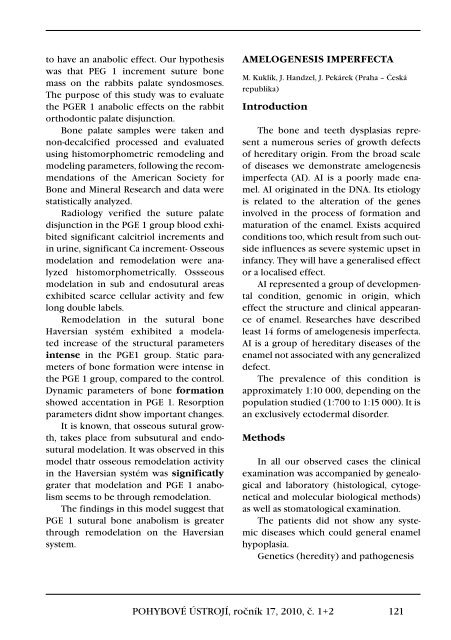1+2/2010 - SpoleÄnost pro pojivové tkánÄ›
1+2/2010 - SpoleÄnost pro pojivové tkánÄ›
1+2/2010 - SpoleÄnost pro pojivové tkánÄ›
You also want an ePaper? Increase the reach of your titles
YUMPU automatically turns print PDFs into web optimized ePapers that Google loves.
to have an anabolic effect. Our hypothesiswas that PEG 1 increment suture bonemass on the rabbits palate syndosmoses.The purpose of this study was to evaluatethe PGER 1 anabolic effects on the rabbitorthodontic palate disjunction.Bone palate samples were taken andnon-decalcified <strong>pro</strong>cessed and evaluatedusing histomorphometric remodeling andmodeling parameters, following the recommendationsof the American Society forBone and Mineral Research and data werestatistically analyzed.Radiology verified the suture palatedisjunction in the PGE 1 group blood exhibitedsignificant calcitriol increments andin urine, significant Ca increment- Osseousmodelation and remodelation were analyzedhistomorphometrically. Ossseousmodelation in sub and endosutural areasexhibited scarce cellular activity and fewlong double labels.Remodelation in the sutural boneHaversian systém exhibited a modelatedincrease of the structural parametersintense in the PGE1 group. Static parametersof bone formation were intense inthe PGE 1 group, compared to the control.Dynamic parameters of bone formationshowed accentation in PGE 1. Resorptionparameters didnt show important changes.It is known, that osseous sutural growth,takes place from subsutural and endosuturalmodelation. It was observed in thismodel thatr osseous remodelation activityin the Haversian systém was significatlygrater that modelation and PGE 1 anabolismseems to be through remodelation.The findings in this model suggest thatPGE 1 sutural bone anabolism is greaterthrough remodelation on the Haversiansystem.AMELOGENESIS IMPERFECTAM. Kuklík, J. Handzel, J. Pekárek (Praha – Českárepublika)IntroductionThe bone and teeth dysplasias representa numerous series of growth defectsof hereditary origin. From the broad scaleof diseases we demonstrate amelogenesisimperfecta (AI). AI is a poorly made enamel.AI originated in the DNA. Its etiologyis related to the alteration of the genesinvolved in the <strong>pro</strong>cess of formation andmaturation of the enamel. Exists acquiredconditions too, which result from such outsideinfluences as severe systemic upset ininfancy. They will have a generalised effector a localised effect.AI represented a group of developmentalcondition, genomic in origin, whicheffect the structure and clinical appearanceof enamel. Researches have describedleast 14 forms of amelogenesis imperfecta.AI is a group of hereditary diseases of theenamel not associated with any generalizeddefect.The prevalence of this condition isap<strong>pro</strong>ximately 1:10 000, depending on thepopulation studied (1:700 to 1:15 000). It isan exclusively ectodermal disorder.MethodsIn all our observed cases the clinicalexamination was accompanied by genealogicaland laboratory (histological, cytogeneticaland molecular biological methods)as well as stomatological examination.The patients did not show any systemicdiseases which could general enamelhypoplasia.Genetics (heredity) and pathogenesisPOHYBOVÉ ÚSTROJÍ, ročník 17, <strong>2010</strong>, č. <strong>1+2</strong> 121
















